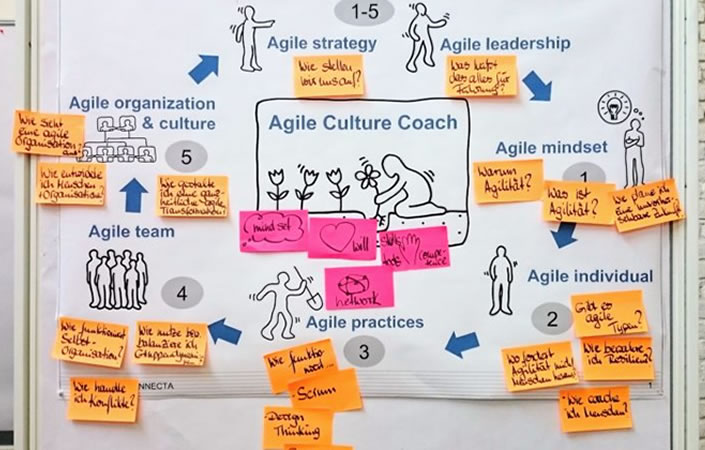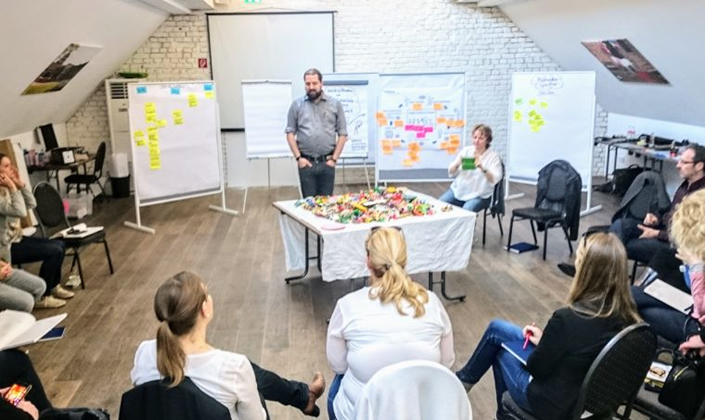
»Agility« and »management control« – that’s a match! Even this year’s large Munich »Controller Congress« agreed when they titled the event »Agile controlling in digital reality: Managing upheavals successfully«, didn’t they? Or is it not a match after all, as some critics raise in discussions time and again? I have a fantastic opportunity: I have been invited to delve deep into the topic with a professional training course to be an »Agile Culture Coach«! These blog contributions will report on my experiences.
This training course takes the form of five modules, which each last several days, over the course of a year: »Agile Leadership and Participation«, »Agility and Personality«, »Agile Methods and Scrum«, »Agile Teams and Conflicts«, »Agile Organization and Culture«. Together with 13 other participants, I am enjoying this training course by and with SYNNECTA, consultants for organizational development and change management in Cologne. It is already the third run of this course: the hosts are visibly proud to be able to name it »the original«.
»Agile Leadership and Participation«
The first three-day-module is titled »Agile Leadership and Participation«. It is a fascinating start which goes far beyond a mere introduction for guidance and terminology. We address »agile strategy« (How to we take position?), »agile leadership« (What does that mean for management?) and »agile mindset« (Why agility? What is agility? How do I plan for an unforeseeable future?)
So, what is »agility«? The views are generally hazy. Our two trainers Renate Standfest and Dr. Johannes Ries are perfectly right to mention that the word »agile« is often even used as an excuse for appointments not kept, responsibilities abused. They make a convincing case, however, that the term has its basis in »valuable thoughts and concepts« that go far beyond »showmanship and bullshit bingo«. It is these notions that give teams, organizations and management a scope for action in the current times, which our trainers describe as a »VUCA situation«.

Our »current times«, dominated as they are by digitalization, political upheaval, climate change, etc. are, as is generally known, described as a »VUCA world«. VUCA comprises »volatility« (instability and fast, ground-breaking change), »uncertainty« (even incalculability), »complexity« and »ambiguity« (without simple cause-and-effect relations, ambiguity is on the fore). »Linear methods« no longer apply in this world of VUCA: so what will work?
How are we to understand »agility«? Out course instructors will not provide a »single, 100 per cent« definition. They note the »dimensions of agility« and recommend the »agile manifesto« as a basis. This »Manifesto for Agile Software Development« (it was signed by 17 persons from the field of programming in 2001) points out several key points:
- they consider »individuals and interactions« more important than processes and tools;
- they deem a »functioning product« more important than extensive documentation;
- they explicitly favour »cooperation with the client« over any (contract) negotiations;
- they expressly consider »reacting to change« more important that following a plan.
The SYNNECTA experts derive 12 principles from this manifesto: client satisfaction, openness for change, iterative development, intensive cooperation, focus on a motivating environment, face-to-face communication, functioning products as a measure of progress, steady speed, technical excellence and good design, simplicity, self-organization and self-reflection. »This list is a good summary of the mindset that is necessary for all agile practices and configurations to work«, states Ries.
Effectuation: means guidance, affordable loss and more
The course focuses on agile practices and methods that facilitate the above-named principles. »Scrum«, for example, is a term that comes from software development and by now has entered further fields. This agile method (it will be treated in depth in the third module of the course) is aimed at reducing the »scale of effort« as far as possible.
»Effectuation« is a concept that particularly catches my interest during this first module of my Agile Coach course. Once again, we are addressing hands-on consequences of the changing world, and in particular our world of work. »The dominant theme here is not ›either or‹, it’s ›as well as‹!«, explains SYNNECTA expert Renate Standfest. »With an uncertain future, where the environment can be changed and the aims negotiated, we’re on perfect ground for effectuation.« We are used to problem-solving by way of »linear causal processes«, but now is the time to recognize the circumstances, coincidences and unplanned events as opportunities and deliberately not draw a line. We are presented with a stimulating list of four principles of effectuation:
- Principle of means guidance: instead of choosing or creating the means and ways to achieve a previously defined goal, this means finding goals and results that are achievable within a given set of means.
- Principle of affordable loss: guide your investment at hand of the affordable loss, not the expected result.
- Principle of circumstances and coincidences: circumstances, coincidences and the unexpected should be used as an opportunity rather than being shut out.
- Principle of agreements and partnerships: to be made with those who are ready to take part.
Module I of my Agile Culture Coach training course is filled to the brim with a plethora of highly interesting input. I am convinced that that’s a match for the world of controlling! There is plenty of thought-provoking content on offer in these first three days alone. I had many, many new insights, from dimensions and principles of agility to effectuation, fascinating methods such as landscaping, the Stacey matrix, daily meetup, etc., and even playful elements like the team-building »marshmallow spaghetti contest« as well as the very personal presentations by the individual course participants at hand of Lego and Duplo bricks.

Hans-Peter Sander
blog.icv-controlling.com
